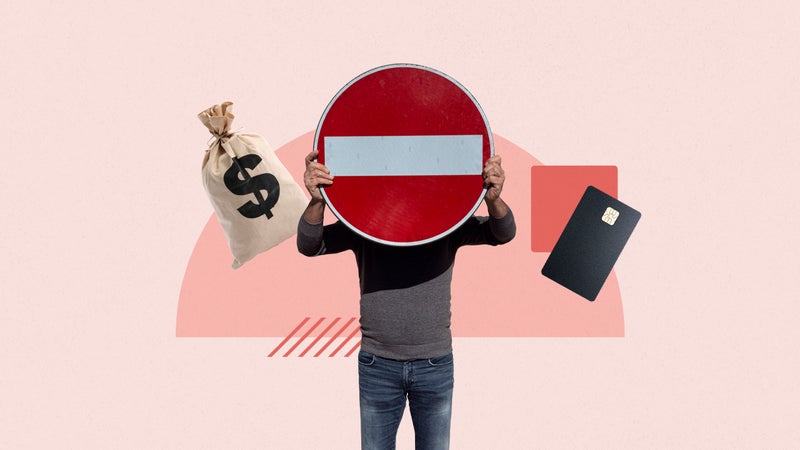Can you get a balance transfer card with bad credit?

The Bankrate promise
At Bankrate we strive to help you make smarter financial decisions. While we adhere to strict , this post may contain references to products from our partners. Here's an explanation for . The content on this page is accurate as of the posting date; however, some of the offers mentioned may have expired. Terms apply to the offers listed on this page. Any opinions, analyses, reviews or recommendations expressed in this article are those of the author’s alone, and have not been reviewed, approved or otherwise endorsed by any card issuer.
Key takeaways
- The best balance transfer cards typically require good to excellent credit.
- If you have bad credit, you might want to consider alternatives like debt consolidation loans, finding a co-signer or taking the time to improve your credit.
- Although you might be able to qualify for a secured card that allows balance transfers, it might be better to put the money you’d use for a security deposit toward paying off your debt instead.
A balance transfer credit card can be a great tool for consolidating debt. A lengthy 0 percent introductory annual percentage rate (APR) offer can help you save money and pay down debt more quickly, but before looking at transferring a balance, you should check your credit score. Unfortunately, balance transfer credit cards for bad credit aren’t easy to come by.
Even if you can qualify for a balance transfer card with poor credit, it’s important to set realistic expectations before applying for one. Consumers with poor credit — a credit score of 579 or below — can’t often qualify for the best 0 percent APR cards. With this score, you probably won’t receive an interest-free window, but you might gain access to a lower APR than you’re currently paying. Ultimately, a balance transfer can still help you save money on interest if you don’t have great credit. You may just have to do so at a slower rate. You should also consider whether another form of debt consolidation might be a better option for you.
Should you do a balance transfer with bad credit?
You might find a balance transfer credit card to approve you even if your credit score is poor, but that doesn’t necessarily mean it’s your best option.
Often, people with poor credit find most of their credit card options are secured credit cards, but these cards aren’t ideal for balance transfers — and many don’t even allow balance transfers. Secured credit cards require a cash deposit, or security deposit, as collateral and your credit limit is usually equal or close to your deposit amount. That means the credit limits, and therefore the amount you could even transfer to the card, are typically quite low. Furthermore, if you have the cash to use as collateral for a secured credit card, you’d likely be better off putting it toward the debt you’re trying to consolidate instead. This means that having a low credit score can sometimes make a balance transfer a bad idea.
There are some unsecured credit cards for bad credit that offer balance transfer options, but you’ll still want to carefully read the terms to understand whether it’s the right move for you.
Pros and cons of a balance transfer card when you have bad credit
If you’re trying to pay down debt while building credit, a balance transfer is a solid option to consider. However, if you currently have bad credit, it can be difficult to qualify for a balance transfer card with terms that actually benefit you. Should you transfer a balance, or should you focus on repairing your credit? Let’s consider some pros and cons of a balance transfer.
Pros
If you succeed in getting a card that offers a lower interest rate than you currently pay, it may position you better to pay down your debt, even after paying a balance transfer fee. That’s provided you are disciplined in your payoff plans.
Plus, with the right card, you can use the card to build your credit and take advantage of rewards after your transferred balance is paid off.
Cons
Most credit cards for bad credit don’t offer preferential interest rates on new purchases, so you’ll want to avoid putting new purchases on your card if you open one for the balance transfer offer.
Another downside is that you’ll likely also have to pay balance transfer fees that will add to your debt amount right away, though you may still save money in the long run by paying lower interest.
It’s also important to remember that you should have a solid repayment plan in place. Unless you’re serious about debt repayment, transferring balances may not help you accomplish anything other than moving debt from one place to another. If you’re opening new cards that give you more available credit and you keep spending as usual, transferring balances could even leave you with more debt to deal with in the end.
Alternatives to a balance transfer if you have bad credit
If you can’t find a balance transfer card for bad credit, or if your balance transfer application is denied, there are some alternatives worth considering. These options might not be perfect, but they can help you to pay off debt more quickly.
Debt consolidation loans
A personal loan can help you consolidate high-interest debt with a fixed interest rate, a fixed monthly payment and a fixed repayment period. Having a set payment each month can make your debt repayment plan easier, and even though you will still pay interest, personal loans for bad credit often come with much lower rates than credit cards for bad credit.
Get a co-signer
If you can’t qualify for a personal loan on your own, you can also consider applying with a co-signer. When you have a co-signer, a family member or friend lends you their good credit to help you qualify. There is risk involved with this option since co-signers are jointly responsible for repaying the amount owed. If you default on the loan, they will be on the hook for making payments or risk damaging their credit score.
Improve your credit score
Don’t lose sight of working to improve your credit score even as you focus on paying down your debt. Improving your credit score should help you qualify for better credit cards with lower rates in the future, even setting you up to qualify for one of the best 0 percent APR credit cards.
Keep chipping away at your debt balance in the meantime, but continue to pay bills on time, live within your means and otherwise do your best to make responsible financial decisions.
Best balance transfer credit cards for bad credit
Balance transfer credit cards for bad credit might help you save money. Before applying, check out Bankrate’s balance transfer calculator to see how much you can actually save with this option. Carefully check the APRs on balance transfers for the card you’re considering — there’s no reason to make a transfer unless you stand to save money over the time you need to pay off your debt.
Each card has its pros and cons, and choosing the right balance transfer card can sometimes be difficult. For example, a secured card like the Discover it® Secured Credit Card might be a good option for you, but you should consider if putting down the required security deposit is worth it for you.
Another option would be the Capital One Platinum Credit Card, but once the introductory APR offer ends, it’ll have a high ongoing variable APR of 29.99 percent that’s only worth it if you’re currently struggling to pay off a card with an even higher APR.
Offerings from your local credit union are also worth looking into. They often feature lower rates than big national banks, especially if you already have a relationship there.
Discover it® Secured Credit Card
Discover it® Secured Credit Card
-
The Discover it® Secured Credit Card lets you transfer balances and pay an intro APR of 10.99 percent for six months (on transfers made within a set timeframe, see terms), followed by a variable APR of 28.24 percent. There’s no annual fee, but there is a 3 percent introductory balance transfer fee to factor in and up to a 5 percent fee for future balance transfers (see terms).
Once you pay off your balance transfer, this card could be a good everyday card as you work to improve your credit. It offers rewards in the form of 2 percent cash back at gas stations and restaurants (on up to $1,000 in combined purchases each quarter, then 1 percent back) and 1 percent back on everything else.
As a secured card, this card requires a security deposit (refundable if you close the account in good standing), so it’s important to consider if that money is better served on your existing card balance.
The bottom line
Qualifying for a balance transfer card for bad credit can be challenging. There’s a good chance you’ll only be eligible for secured credit cards, which require a cash deposit, so you may be better off simply putting that cash toward paying off your debt.
If it seems like that would barely make a dent, consider other ways to consolidate. Focus on managing your debt with on-time monthly payments and work on improving your credit so you can qualify for an unsecured balance transfer card with superior rates and terms.




